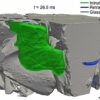Recent Australian-led research has provided a world’s first measurement of interactions between Fermi polarons in an atomically-thin 2D semiconductor, using ultrafast spectroscopy capable of probing complex quantum materials.
Researchers at Swinburne University of Technology found the signatures of interactions between exciton-polarons in experiments on the 2D semiconductor monolayer tungsten-disulfide.
FLEET collaborators at Monash University and RMIT developed a theoretical model to explain the experimental signals. They found that repulsive interactions at long-range are mediated by a phase-space filling effect, while attractive interactions at short range led to the formation of a cooperatively bound exciton-exciton-electron state.
The material
Tungsten-disulfide (WS2) comes from the family of semiconducting transition metal dichalcogenides (TMDCs). When the bulk material is exfoliated down to a single atomic monolayer (less than 1 nanometre thick), the physics of these 2D materials becomes really interesting, and controllable.
Much of the intriguing physics is described by the creation and interactions of quasiparticles. Excitons are one such quasiparticle, and they dominate the optical response of monolayer WS2. Excitons are formed when electrons from the valence band are excited into the conduction band. The vacancy left behind (a hole) can then bind to the excited electron through Coulomb forces, forming the exciton.
“This picture gets more complex when there are excess electrons in the monolayer,” explains lead author Jack Muir. “These ‘spare’ electrons can sit in the conduction bands and don’t interact directly with light. The exciton can then bind to these excess electrons forming trions.”
Fermi polarons
But what happens if the density of the doping is increased? No longer is there just one electron for each exciton, but five, ten, hundreds… At this point, the exciton can be considered as a defect in a sea of electrons. Interactions between an exciton and the Fermi sea of electrons leads to the formation of new quasiparticles—polarons.
As Monash Professor Meera Parish points out, “having a defect in a Fermi sea is a universal problem beyond 2D semiconductors. Polaron quasiparticles play an important role in a range of systems including cold atomic gases and even the inner crust of neutron stars.”
The experiment
Multi-dimensional coherent spectroscopy (MDCS) utilizes four precisely-controlled ultrafast laser pulses to reveal and quantify interactions.
“Most spectroscopic techniques, like photoluminescence, are unable to separate interactions from the single particle response. MDCS is optimized to do just that,” explains corresponding author Professor Jeffrey Davis.
Varying the polarization of the different pulses revealed an interesting observation: There are only interactions between Fermi polarons when they are coupled to the same Fermi sea.
“It was exciting, nothing like this had been seen before in these systems and the physics behind it was new,” says Jack.
Phase-space filling
The mechanism of these interactions was identified to come from a “phase-space filling” effect:
When an electron in the Fermi sea interacts with one exciton as part of a polaron, it is unable to be involved in forming another polaron. This results in a repulsive force between polarons, and explains the selective interaction that we observe with the experiment.
Strongly-bound bipolaron
Attractive interactions between polarons, leading to the formation of bipolarons were also identified. The remarkably large binding energy of these bipolarons is believed to be unique to tungsten-based TMDCs and is a result of the specific band ordering in WS2.
The identification of both repulsive and attractive interactions, and the underlying mechanisms, is an important step to fully understanding Fermi polarons and quasiparticle interactions more broadly. With this input we are one step closer to unraveling the rich physics of complex materials and controlling their remarkable macroscopic properties.
The research was published in Nature Communications.
More information:
Jack B. Muir et al, Interactions between Fermi polarons in monolayer WS2, Nature Communications (2022). DOI: 10.1038/s41467-022-33811-x
Provided by
ARC Centre of Excellence in Future Low-Energy Electronics Technologies
Citation:
First measurement of interactions between Fermi polarons in an atomically-thin 2D semiconductor (2022, October 20)


